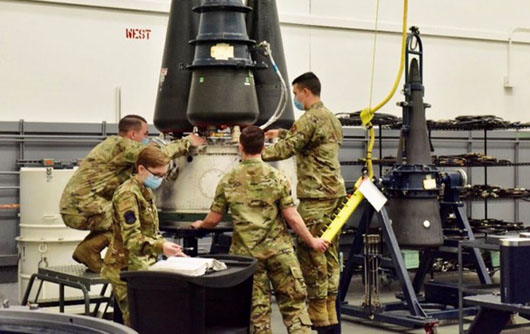FPI / August 5, 2020
By Richard Fisher
Recent Chinese and American statements, plus a sobering assessment of Russia’s potential nuclear weapons buildup, points to a potential period of superpower nuclear weapons buildup to force the issue of new nuclear arms control agreements, primarily because China refuses to enter into such negotiations.

Under the limits of the 2010 New START Treaty, the U.S. and Russia may only deploy 1,550 warheads on ICBMs, sea-launched ballistic missiles (SLBMs) and bombers. But this treaty expires on Feb. 21, 2021.
China is not party to the New START Treaty and has repeatedly over 2019 and 2020 refused to join the U.S. and Russia in new nuclear negotiations, now underway in Vienna.
Instead, on July 26, China signaled its desire to build up its nuclear weapons, when Hu Xijin, the editor of China’s hardline state media outlet Global Times, issued his second call for China to buildup its nuclear weapons, following his May 8 call for China to build up to 1,000 warheads.
In his latest call Hu stated, “Hurry up and build more nuclear missiles to deter the U.S. lunatics…we cannot rule out the possibility that clashes break out between China and the U.S. in the South China Sea and the Taiwan Strait. There will be a contest of wills…and sufficient nuclear weapons are an indispensable pillar of China’s will.”
Hu Xijin may only be confirming what China is doing already; China’s People’s Liberation Army (PLA) is now deploying or developing eight types of land-based or sea-based intercontinental range nuclear missiles.
China is already testing a very difficult to intercept and range enhancing hypersonic glide vehicle (HGV) warhead for one type of ICBM.
Informal Chinese sources indicate that it is also developing a new silo-based very large solid-fuel ICBM that may carry 10s of warheads.
The sources suggest a future Chinese nuclear force may grow from a current estimate of 300 to 1,500 warheads or more, but such figures cannot be confirmed officially. This is because China rejects Western ideas that military transparency can strengthen strategic nuclear stability and refuses to reveal any data about its current or future nuclear forces.
Meanwhile, veteran government and private sector analyst of Russian nuclear trends, James R. Howe, Vice President at Vison Centric Inc., has produced a briefing “Russian Strategic Nuclear Force Potential 2030 Force Projections,” in which he concluded the following:
“After looking at the breadth and depth of Russian SNF [Strategic Nuclear Force] modernization and expansion, it is evident that Russia had no, repeat no intention of abiding by or remaining within New START Treaty limits.”
More . . . . Current Edition . . . . Subscription Information
FPI, Free Press International
